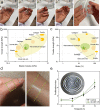Self-Assembly of Nanocellulose Hydrogels Mimicking Bacterial Cellulose for Wound Dressing Applications
- PMID: 37097826
- PMCID: PMC10170512
- DOI: 10.1021/acs.biomac.3c00152
Self-Assembly of Nanocellulose Hydrogels Mimicking Bacterial Cellulose for Wound Dressing Applications
Abstract
The self-assembly of nanocellulose in the form of cellulose nanofibers (CNFs) can be accomplished via hydrogen-bonding assistance into completely bio-based hydrogels. This study aimed to use the intrinsic properties of CNFs, such as their ability to form strong networks and high absorption capacity and exploit them in the sustainable development of effective wound dressing materials. First, TEMPO-oxidized CNFs were separated directly from wood (W-CNFs) and compared with CNFs separated from wood pulp (P-CNFs). Second, two approaches were evaluated for hydrogel self-assembly from W-CNFs, where water was removed from the suspensions via evaporation through suspension casting (SC) or vacuum-assisted filtration (VF). Third, the W-CNF-VF hydrogel was compared to commercial bacterial cellulose (BC). The study demonstrates that the self-assembly via VF of nanocellulose hydrogels from wood was the most promising material as wound dressing and displayed comparable properties to that of BC and strength to that of soft tissue.
Conflict of interest statement
The authors declare no competing financial interest.
Figures







